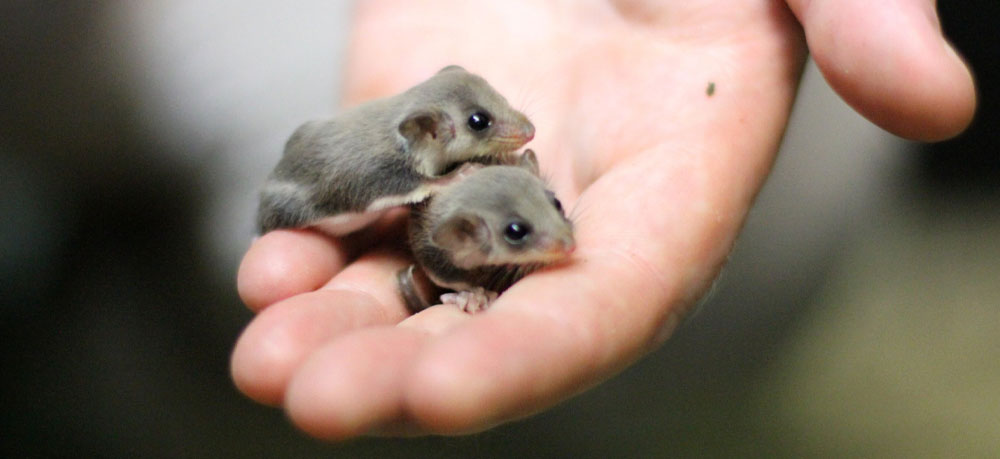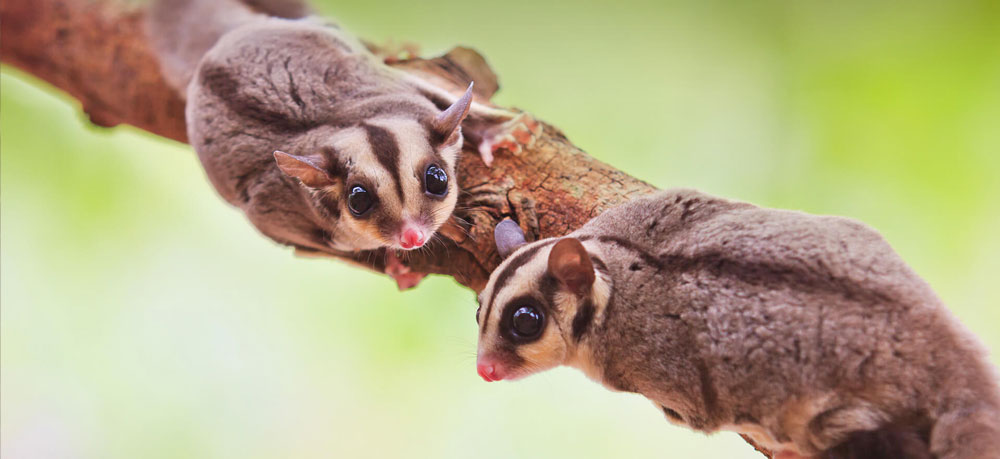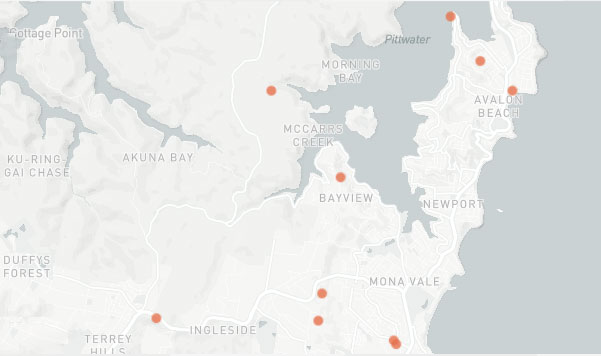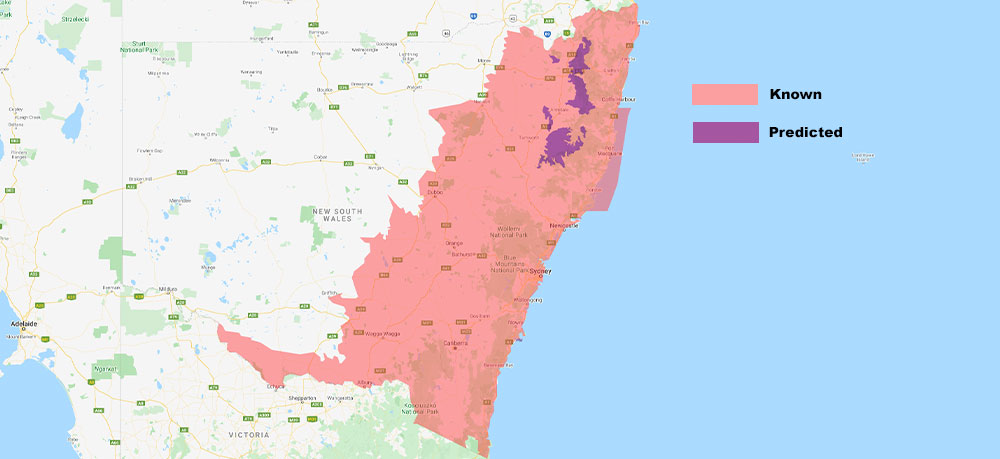Fauna
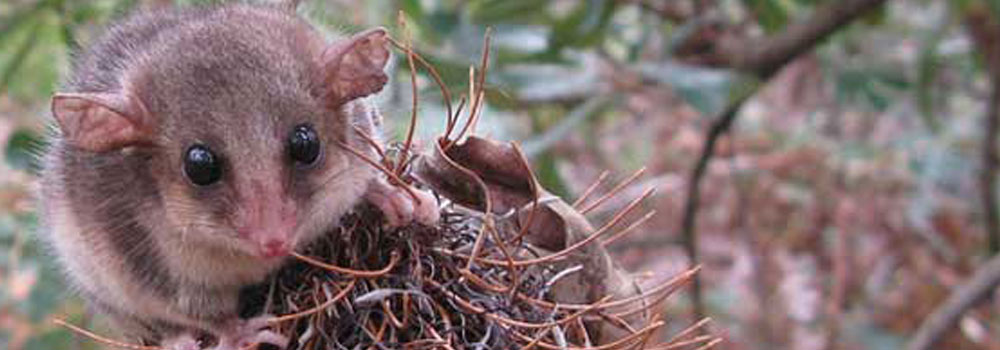
Gliding possums
Gliding possums are marsupials sometimes referred to as flying phalangers, or simply as gliders.
There are many types of gliding possums, from tiny feathertail gliders that are the size of a small mouse to the almost cat-sized greater gliders.
-
Feathertail Glider
Scientific name: Acrobates pygmaeus
The Feathertail Glider is the smallest gliding mammal in the world with an average weight of only 12 g. They measure between 6.5 to 8cm in length from head to body.
They are mouse-shaped and have grey-brown fur on the back and a white underbelly.
The distinctive tail is quill-like and hairless, except for a fringe of long stiff hairs down either side that resemble a feather. Their tail is about 7 to 8cm long.
Feathertail gliders only weigh between 10 and 15 grams.
Their gliding membrane extends from elbow to knee and is thicker than other glider species.
Identification
The Feathertail Glider is distinguished from other small marsupials by its feather-like tail fringed with long stiff hairs, which acts as a rudder during flight. A gliding membrane, which extends from its elbows to its knees, allows the animal to glide more than 20 m between trees. It clings to smooth surfaces with its large serrated toe pads.
Habitat
The Feathertail Glider lives in forests and woodlands.
Distribution
The Feathertail Glider is found in eastern Australia from Queensland, New South Wales, Victoria and South Australia.
Feeding and diet
It feeds on pollen, nectar and insects.
Predators
Predators of the Feathertail Glider include currawongs, kookaburras, foxes and cats.
-
Sugar Glider
Scientific name: Petaurus breviceps
Common name: Sugar glider
Conservation status in NSW: Protected
Description:
The sugar glider’s (Petaurus breviceps) fur is a blue-grey to brown-grey, with a dark stripe that extends from the middle of the head to the mid-back region.
They are about the size of a rat with adults weighing between 100 to 160 grams. They have a round face and their tail is thick and may have a white tip.
The Sugar Glider has a membrane extending from its fifth finger to its ankle enabling it to glide up to 50 m between trees.
They is highly social, living in small colonies or family groups numbering up to seven adults and their offspring. Sugar gliders are largely nocturnal and rarely come to the ground, finding both shelter and food in the trees.
The sugar glider’s main distinguishing feature is a soft membrane between its wrists and ankles called a patagium, which allows it to glide from tree to tree as though using a parachute. These “wrist-winged gliders” can float on air up to a distance nearly the width of a football field!
They are excellent “aviators,” thanks to their wide field of vision—and they can triangulate distances and glide ratios by bobbing their head before launch. Once airborne, they steer toward their target by tilting their hands and arms, adjusting the tension in their “wings,” and using their long, flat, bushy tail as a rudder.
While named for their penchant for eating forest sweets like acacia gum, eucalyptus sap, and flower nectar, sugar gliders are actually omnivorous opportunistic feeders, consuming both plant and animal matter. The little sugar glider’s menu choice has a dark side, though. Their appetite for the endangered swift parrot’s nestlings in Tasmania is a grave threat to the bird’s survival there.
Being pocket-sized with big eyes and having the unusual “superpower” of gliding makes this marsupial popular in the pet world. But wildlife—even adorable ones—typically do not make good household pets. They are long lived and require plenty of space and others of their own kind to thrive.Identification
In flight, the Sugar Glider it uses its long bushy tail for stability and steering.
Habitat
The Sugar Glider lives in forests and woodlands.
Distribution
The Sugar Glider is found in northern and eastern Australia, including northern Western Australia, Northern Territory, Queensland, New South Wales, Victoria, Tasmania and south-eastern South Australia.
Other behaviours and adaptations
The Sugar Glider is most active at night, sleeping by day in nests made of leaves in tree hollows. Groups of up to seven adults and their young may form a ‘clan’ and share a nest. Among their own clan they are playful and social but will defend their territory aggressively and noisily if threatened by other animals or approached by Sugar Gliders from a different clan. Dominant males mark other clan members and the territory around the nest with secretions from scent glands on their chest.
Life history cycle
The Sugar Glider commonly gives birth to twins, which remain in the pouch for just over two months. They then leave the nest to forage for food, usually with their mother.
Sources: Australian Museum, San Diego Zoo
-
Squirrel Glider
Scientific name: Petaurus norfolcensis
Conservation status in NSW:Vulnerable
Commonwealth status: Not listed
Profile last updated: 01 Dec 2017Description
Adult Squirrel Gliders have a head and body length of about 20 cm. They have blue-grey to brown-grey fur above, white on the belly and the end third of the tail is black. There is a dark stripe from between the eyes to the mid-back and the tail is soft and bushy averaging about 27 cm in length. Squirrel Gliders are up to twice the size of Sugar Gliders, their facial markings are more distinct and they nest in bowl-shaped, leaf lined nests in tree hollows. Squirrel Gliders are also less vocal than Sugar Gliders.Feeding and diet
Squirrel Gliders are omnivores who feed at night.They live primarily on insects (mainly catepillars,beetles and stick insects) but also on pollen and nectar (mostly from eucalypts). Plant exudates such as sap or resin from wattle and eucalypt trees, are similarly an important part of a Squirrel Glider’s diet.Obtaining food from any one of these sources usually depends on seasonal influences.
Other behaviours and adaptations
Being arboreal, Squirrel gliders are very adept at climbing.They are rarely found on the ground and are able to glide from limb to limb of trees using the membranes of skin that stretches between their front and back legs.They have been observed to glide up to 100 metres with the assistance of a downhill slope and up to 50 metres over flatter terrain. To steer and maintain stability, the curvature of either the left or right membrane can be varied. As they approach to land, Squirrel Gliders bring their hind legs closer to their body, make an upward swoop and land on some bark on all fours.
Squirrel Gliders take shelter in tree hollows during the day and will come out only at night.Large light sensitive eyes allow for increased night vision.Movement along branches is in small bounds. They have been known to freeze or hide when detected by a spotlight.
Communication
To communicate, Squirrel Gliders are known to utter a soft nasal gutteral call, interspersed with gurgling chatter. To raise the alarm when disturbed by predators, often a loud yip can be heard.
Life history cycle
In south eastern Australia breeding usually begins in August with each female producing two young. The young newborns will remain in the pouch for about seventy days. Here they attach to the mother’s teat being nourished with their mother’s milk. After this period they are depositied in the nest for another month or so and forage for food with the adults.By four months of age, the young Squirrel Gliders are ready to leave the nest and establish their own territories. Some females may stay with the group but usually males will leave.
Breeding behaviours
The ability to breed is usually reached around 12 months of age. For males, a scent gland is present on the top of their head. It is found in the middle of the dark strip of fur that extends from the nose to the middle of the back.
Nests are bowl-shaped, lined with leaves and found in tree hollows.
A typical family group consists of one mature male (over two years of age) and one or two mature females with their offspring. The numbers can increase to up to five adults with the inclusion of one or two young males (not more than two years old) to the group.In total there can be up to ten members in a family group.
Conservation status
Squirrel Gliders are listed as: vulnerable in NSW, threatened in Victoria, endangered in South Australia and common in Queensland.
The main threats facing Squirrel Gliders today stem from the fragmentation of their habitat. Coupled with this the loss of trees with suitable hollows for nesting and the loss of food souces contained in the flowering mid storey shrubs,has compounded threats to their habitats.
Barbed wire fences have also contributed to their demise especially when gliding.Additionally attacks by feral cats have accounted for high losses in Squirrel Glider numbers. If you do own a cat, please ensure it is kept inside at night or is fitted with some large bells to allow possums to escape from these hunters.
Do you want to help?
Consider placing a nesting box in your yard.
Hand-made nesting boxes are only $25 each and are easy to install.
Contact Lesley Stevens by email for more information or to order.
